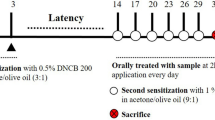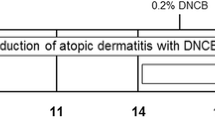Abstract
Allergic contact dermatitis (ACD) is a classical experimental model of allergic inflammatory skin disease, which is a delayed-type hypersensitivity reaction that is mediated by hapten-specific T lymphocytes. The goal of this study was to investigate the pharmacokinetic profiles of 6′-acetylpaeoniflorin (6-AP) and the effect of 6-AP on the ACD model. 6-AP was synthesized from paeoniflorin (Pae) via acetylation, and the structure was confirmed. There were statistically significant differences in the pharmacokinetic parameters including t 1/2α , t 1/2β , AUC, MRT and C max among the animals that were orally administered Pae and 6-AP. An ACD model was induced using immunization with dinitrochlorobenzene (DNCB) in BALB/c mice. The mice were orally administered 6-AP (35, 70 and 140 mg/kg/d), Pae (70 mg/kg/d) and prednisone (Pre, 5 mg/kg/d) from day 1 to day 7 after immunization. The results indicated that the topical application of DNCB to the skin provoked obvious inflammatory responses. 6-AP significantly inhibited ear swelling and decreased inflammatory cell infiltration and epidermal keratinization. Additionally, 6-AP observably alleviated the hyperplasia of red pulp and germinal center appearance, decreased the spleen index and inhibited splenocyte proliferation in the ACD model compared to that of Pae. Furthermore, the study indicated that 6-AP could increase the IL-10 level, while simultaneously reducing the IL-17 level in splenocytes. In summary, these results suggest that 6-AP has a significantly higher anti-inflammatory effect than Pae and that 6-AP might be a candidate for the treatment of allergic skin diseases.









Similar content being viewed by others
References
Tang QQ, Zou P, Jin HF, Fu J, Yang JT, Shang LQ, Wei XT. Grape-seed proanthocyanidins ameliorate contact hypersensitivity induced by 2,4-dinitrofluorobenzene (DNFB) and inhibit T cell proliferation in vitro. Toxicol Lett. 2012;210(1):1–8.
Choi JK, Kim SH. Rutin suppresses atopic dermatitis and allergic contact dermatitis. Exp Biol Med. 2013;238(4):410–7.
Yuan XY, Liu W, Zhang P, Wang RY, Guo JY. Effects and mechanisms of aloperine on 2,4-dinitrofluorobenzene-induced allergic contact dermatitis in BALB/c mice. Eur J Pharmacol. 2010;629(1–3):147–52.
Akhtar N, Satyam A, Anand V, Verma KK, Khatri R, Sharma A. Dysregulation of T(H) type cytokines in the patients of Parthenium induced contact dermatitis. Clin Chim Acta. 2010;411:2024–8.
Harrington LE, Hatton RD, Mangan PR, Turner H, Murphy TL, Murphy KM, Weaver CT. Interleukin 17-producing CD4 + effector T cells develop via a lineage distinct from the T helper type 1 and 2 lineages. Nat Immunol. 2005;6(11):1123–32.
Wang BH, Zhuang LH, Fujisawa H, Shinder GA, Feliciani C, Shivji GM, Suzuki H, Amerio P, Toto P, Sauder DN. Enhanced epidermal Langerhans cell migration in IL-10 knockout mice. J Immunol. 1999;162(1):277–83.
Choi YY, Kim MH, Lee JY, Hong J, Kim SH, Yang WM. Topical application of Kochia scoparia inhibits the development of contact dermatitis in mice. J Ethnopharmacol. 2014;154(2):380–5.
Chang Y, Wei W, Zhang L, Xu HM. Effects and mechanisms of total glucosides of paeony on synoviocytes activities in rat collagen-induced arthritis. J Ethnopharmacol. 2009;121(1):43–8.
Zheng YQ, Wei W. Total glucosides of paeony suppresses adjuvant arthritis in rats and intervenes cytokine-signaling between different types of synoviocytes. Int Immunopharmacol. 2005;5(10):1560–73.
Wang QS, Gao T, Cui YL, Gao LN, Jiang HL. Comparative studies of paeoniflorin and albiflorin from Paeonia lactiflora on anti-inflammatory activities. Pharm Biol. 2014;52(9):1189–95.
Zhou Z, Lin J, Huo R, Huang W, Zhang J, Wang L, Sun Y, Shen B, Li N. Total glucosides of paeony attenuated functional maturation of dendritic cells via blocking TLR4/5 signaling in vivo. Int Immunopharmacol. 2012;14(3):275–82.
Min WQ, Wei Q, Li HY, Zhang ZC, Wu LJ, Yuan GH, Dou CR, Shi GY. A clinical study of total glucosides paeony in the treatment of rheumatoid arthritis: a multi-center trial. Chin J Rheumatol. 2005;9:487–91.
Wang C, Wei W. Research progress of pharmacokinetic study on paeoniflorin. Chin Pharmacol Bull. 2014;30(12):1646–50.
Nam KN, Yae CG, Hong JW, Cho DH, Lee JH, Lee EH. Paeoniflorin, a monoterpene glycoside, attenuates lipopolysaccharide-induced neuronal injury and brain microglial inflammatory response. Biotechnol Lett. 2013;35(8):1183–9.
Li PP, Liu DD, Liu YJ, Song SS, Wang QT, Chang Y, Wu YJ, Chen JY, Zhao WD, Zhang LL, Wei W. BAFF/BAFF-R involved in antibodies production of rats with collagen-induced arthritis via PI3 K-Akt-mTOR signaling and the regulation of paeoniflorin. J Ethnopharmacol. 2012;141(1):290–300.
Sun Y, Zhang J, Huo RF, Zhai TH, Li HD, Wu PR, Zhu XJ, Zhou Z, Shen BH, Li NL. Paeoniflorin inhibits skin lesions in imiquimod-induced psoriasis-like mice by downregulating inflammation. Int Immunopharmacol. 2015;24(2):392–9.
Wang C, Yuan J, Wu HX, Chang Y, Wang QT, Wu YJ, Liu LH, Wei W. Paeoniflorin inhibits inflammatory responses in mice with allergic contact dermatitis by regulating the balance between inflammatory and anti-inflammatory cytokines. Inflamm Res. 2013;62(12):1035–44.
Takeda S, Isono T, Wakui Y, Matsuzaki Y, Sasaki H, Amagaya S, Maruno M. Absorption and excretion of paeoniflorin in rats. J Pharm Pharmacol. 1995;47(12A):1036–40.
Wang C, Yuan J, Yang ZY, Nie XX, Song LH, Wei W. Pharmacokinetics of paeoniflorin microemulsion after repeated dosing in rats with adjuvant arthritis. Pharmazie. 2012;67(12):997–1001.
Liu ZQ, Jiang ZH, Liu L, Hu M. Mechanisms responsible for poor oral bioavailability of paeoniflorin: role of intestinal disposition and interactions with sinomenine. Pharm Res. 2006;23(12):2768–80.
Ogawa T, Araki M, Miyamae T, Okayama T, Hagiwara M, Sakurada S, Morikawa T. Synthesis and antinociceptive activity of orally active opioid peptides: improvement of oral bioavailability by esterification. Chem Pharm Bull. 2003;51(7):759–71.
Yang XW, Guo J, Xu W. Absorption and transport characteristic of paeoniflorin and its derivatives in model of Caco-2 cell monolayers. Chin Tradit Herb Drugs. 2013;44(15):2097–104.
Vlachogianni IC, Fragopoulou E, Kostakis IK, Antonopoulou S. In vitro assessment of antioxidant activity of tyrosol, resveratrol and their acetylated derivatives. Food Chem. 2015;177:165–73.
Delmas D, Aires V, Limagne E, Dutartre P, Mazué F, Ghiringhelli F, Latruffe N. Transport, stability, and biological activity of resveratrol. Ann N Y Acad Sci. 2011;1215:48–59.
Wang C, Yuan J, Wu HX, Chang Y, Wang QT, Wu YJ, Zhou P, Yang XD, Yu J, Wei W. Total glucosides of paeony inhibit the inflammatory responses of mice with allergic contact dermatitis by restoring the balanced secretion of pro-/anti-inflammatory cytokines. Int Immunopharmacol. 2015;24(2):325–34.
Germolec DR, Nyska A, Kashon M, Kuper CF, Portier C, Kommineni C, Johnson KA, Luster MI. Extended histopathology in immunotoxicity testing: interlaboratory validation studies. Toxicol Sci. 2004;78(1):107–15.
Zhang LL, Wei W, Yan SX, Hu XY, Sun WY, et al. Therapeutic effects of glucosides of Cheanomeles speciosa on collagen-induced arthritis in mice. Acta Pharmacol Sin. 2004;25:1495–501.
Liu K, Xu Q. Roxithromycin inhibits the effector phase of delayed-type hypersensitivity. Int Immunopharmacol. 2008;8(1):126–31.
Shi DM, Li XF, Li DM, Zhao QJ, Shen YN, Yan HX, Fu HJ, Zheng HL, Lu GX, Qiu Y, Liu WD. Oral administration of paeoniflorin attenuates allergic contact dermatitis by inhibiting dendritic cell migration and Th1 and Th17 differentiation in a mouse model. Int Immunopharmacol. 2015;25(2):432–9.
Simon D, Aeberhard C, Erdemoglu Y, Simon HU. Th17 cells and tissue remodeling in atopic and contact dermatitis. Allergy. 2014;69(1):125–31.
Akhtar N, Verma KK, Sharma A. Study of pro- and anti-inflammatory cytokine profile in the patients with parthenium dermatitis. Contact Dermat. 2010;63(4):203–8.
Aleksandrov AP, Mirkov I, Demenesku J, Ninkov M, Zolotarevski L, Kataranovski D, Kataranovski M. Strain differences in contact hypersensitivity reaction to dinitrochlorobenzene (DNCB) in rats. Food Chem Toxicol. 2015;75:94–103.
He DG, Wu LZ, Kim HK, Li H, Elmets CA, Xu H. CD8 + IL-17-producing T cells are important in effector functions for the elicitation of contact hypersensitivity responses. J Immunol. 2006;177(10):6852–8.
Moed H, Von Blomberg BME, Bruynzeel DP, Scheper RJ, Gibbs S, Rustemeyer T. Regulation of nickel-induced T-cell responsiveness by CD4 + CD25 + cells in contact allergic patients and healthy individuals. Contact Dermat. 2005;53(2):71–4.
Minang JT, Areström I, Zuber B, Jönsson G, Troye-Blomberg M, Ahlborg N. Nickel-induced IL-10 down-regulates Th1- but not Th2-type cytokine responses to the contact allergen nickel. Clin Exp Immunol. 2006;143(3):494–502.
Cao WJ, Zhang W, Liu JJ, Wang Y, Peng XM, Lu DX, Qi RB, Wang YP, Wang HD. Paeoniflorin improves survival in LPS-challenged mice through the suppression of TNF-a and IL-1b release and augmentation of IL-10 production. Int Immunopharmacol. 2011;11:172–8.
Acknowledgments
This work was financially supported by the National Natural Science Foundation of China (Nos. 81330081, 81302845, 81473223), the Training programme of Academic and technical leaders in universities of Anhui province (No. 34), the Anhui Province Nature Science Foundation in University (No. KJ2013A158) and the Grants for Scientific Research of BSKY (No. XJ201211) from Anhui Medical University.
Author information
Authors and Affiliations
Corresponding authors
Ethics declarations
Conflict of interest
The authors have no conflict of interest to declare.
Ethical standard
All of the applicable international, national and/or institutional guidelines for the care and use of animals were followed.
Electronic supplementary material
Below is the link to the electronic supplementary material.
Rights and permissions
About this article
Cite this article
Zhou, P., Yang, X., Jia, X. et al. Effect of 6′-acetylpaeoniflorin on dinitrochlorobenzene-induced allergic contact dermatitis in BALB/c mice. Immunol Res 64, 857–868 (2016). https://doi.org/10.1007/s12026-016-8788-8
Published:
Issue Date:
DOI: https://doi.org/10.1007/s12026-016-8788-8




